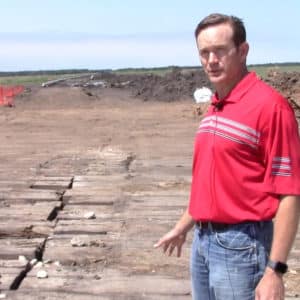What Does Double Ditching Mean for the Landowner?
As a landowner, you likely want to preserve the value and productivity of your land even though an easement may cross your property. If you’re negotiating a pipeline easement, you should consider requiring the pipeline construction company to use double ditching when laying the pipe. Texas Condemnation Rights Attorney Philip Hundl explains in this video.
Your attorney can help you get this done. If you need help negotiating this provision or any other aspect of your easement agreement, please call our office at 1-800-266-4870.
Summary of the What’s Double Ditching in an Easement Agreement Video
– – All right, we’re here at the FM 1301, looking at the staging of the pipeline, the Florida Gas Transmission line. They’ve moved over the topsoil, about a foot and a half of it, to one side to commence the double ditching.

Once they dig the ditch, they’ll lay pipe, and then put that same subsoil on top of the pipe and then the topsoil on top. So that’ll be the double ditching that they do.
As a landowner with cropland or pasture, you want to bargain for double ditching to be included in the easement agreement. If it’s not, the pipeline construction contractor will likely mix your topsoil with the subsoil, and your pasture and cropland will be damaged for many years to come.
If you have questions about double ditching or any aspect of negotiating your easement agreement, please call our office at 800-266-4870 for an appointment with Attorney Philip Hundl.
Mr. Hundl is a partner with the law firm of Land Rights Law and he represents landowners in eminent domain and condemnation proceedings. If you’re impacted by a pipeline project, you should get the help of a knowledgeable lawyer to guide you through the condemnation process. Call Phil and his team at 800-266-4870 or text the office at 979-320-9320. Our offices are in Wharton County, and we help landowners all over Texas.
Call 800-266-4870 or text 979-320-9320 for an appointment. We can also arrange for online and telephone appointments all over Texas.